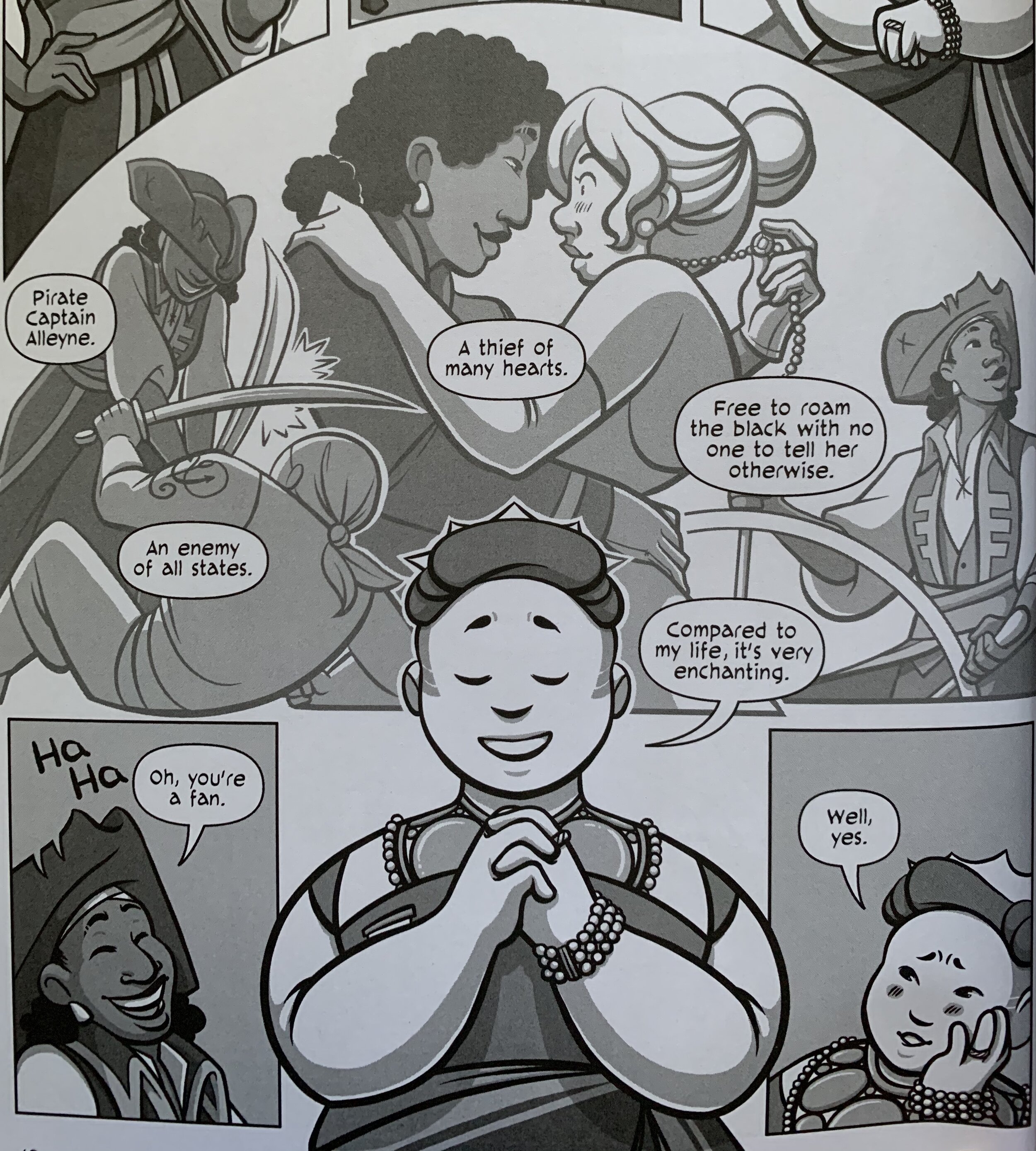“A Royal Affair” by Christianne Goudreau & Taneka Stotts is a mini-comic about the brief encounter of space pirate Captain Naideen Alleyne and Ri’an Chiarthi gol Rune the VI, Regent of Calofi. This mini-comic is featured in Beyond: The Queer Sci-Fi & Fantasy Anthology, edited by Sfé R. Monster.
What makes science fiction so useful for the deconstruction of gender?
Fiction is all about creating the inexistant. Creators make use of their experiences and creativity to breathe life into a myriad of characters and situations. Depending on the genre, these creations can rage from grounded realism to the wildest of surrealist fantasies. Science fiction, however, is a bit of a wild card when it comes to this spectrum, as well as a point of contention between its followers. For some, science fiction must be securely rooted in scientific fact to emphasize the fictional exploration of science itself. For others, science fiction is a means to explore the the realm of possibility that the development of science could bring. For example, by projecting development of space travel into the future through fiction, the idea of different planets with their own cultures and societies can be developed. This is the approach that “A Royal Affair” takes to deconstruct our ideas of gender.
Credits: Christianne Goudreau & Taneka Stotts
A single panel.
Captain Alleyne and Regent Ri’an are speaking from opposite ends of a great hall. The wall beside them, in the background of the panel, features an elaborate mural of a king holding a saber and shield and queen holding a scepter and bundle of wheat. They stand opposite each other, crossing the saber and scepter. Behind them, two snakes cross each other against a radiant sun.
Ri’an: Blood has little to do with it. A King of Calofi is expected to be strong. A Queen serene. One wields the power of the military, while the other handles the affairs of the state. Both are respected, but neither equal. The choice is for the benefit of the people.
A fundamental concept of science fiction to remember is that, no matter how extravagantly different and exotic these alien worlds seem, the stories told in them are all about our world. These imagined worlds are all created in reference to our own, whether by comparison, contrast or both, and the catalyst of their inception is speculation. What if there were a society without deities? What if there were a world with two or more dominant sapient species? What if there were a world were reproduction isn’t sexual? Or in the case of the world of Calofi, what if there were a world where gender is deliberately chosen later in life as opposed to assigned at birth? Like our world, Calofi seems to mostly function on a gender binary (comparison), but unlike our world, one’s gender expression — or at least that of the Regent — is personally chosen and not an inherent extension of one’s sex (contrast). In spite of this, however, the choice lies between only two expressions of gender, and the attributes associated with each one seem to be mutually exclusive. Again, these stories are about our world.
Credits: Christianne Goudreau & Taneka Stotts
A three-panel page with a breakout illustration of Regent Ri’an in the middle with their eyes closed and hands together against their chest.
First Panel: A group of illustrations of Captain Alleyne’s adventures, featuring a sword fight, a dance with a blushing woman as she steals her necklace, and her steering her ship.
Ri’an: Pirate Captain Alleyne. An enemy of all states. A thief of many hearts. Free to roam the black with no one to tell her otherwise. Compared to my life, it’s very enchanting.
Second Panel: Captain Alleyne is laughing from Ri’an’s comments about her life as a pirate.
Alleyne: Oh, you’re a fan.
Third Panel: A close-up of Ri’an holding their cheek as they blush.
Ri’an: Well, yes.
By playing with the overall concept of gender, be it through the conceptualization of a slightly different gender dynamic, or by a character like Captain Alleyne that challenges the expectations the pirate adventure genre by being a Black female captain, comics like “A Royal Affair” ask their readers to stretch their imaginations to question the world around them. When I think of a pirate captain, what kind of character do I imagine? When I’m planning a story with a royal family, does it have to work the exact same way as it does in European society? Oftentimes, it’s difficult to disentangle ourselves from the frameworks we were born into, such as gender, race, class, nationality… Science fiction, by merit of its speculative nature, allows creators to deconstruct all of these frameworks. Simply tear it apart, see how it works, then put back together in a different way. How does it work now? The answer might shed more light than originally expected.

